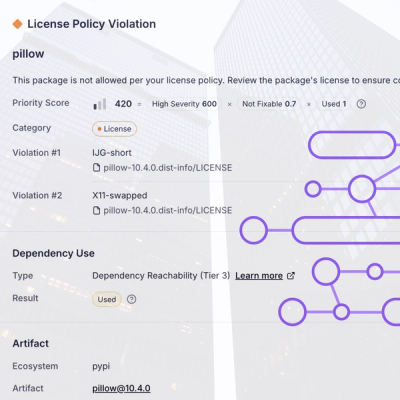
Research
/Security News
Critical Vulnerability in NestJS Devtools: Localhost RCE via Sandbox Escape
A flawed sandbox in @nestjs/devtools-integration lets attackers run code on your machine via CSRF, leading to full Remote Code Execution (RCE).
pyboro is a utility for lexing and consuming input by setting up regular expression tables and building syntax maps.
pyboro is a regular expression lexer built with python.
pyboro is suitable for parsing syntax and building symbol tables, and it's easy to use this information to extend into building your own code generation and so on.
The name comes from 'borosilicate', which is the type of glass used in making Pyrex glassware. The repository was originally called pyRex, but this conflicted with similarly named packages already existing in PyPi.
pip install pyboro
easy_install pyboro
Then: import pyboro Or: from pyboro import Lexer from pyboro import Consumer
The Lexer module (pyboro.Lexer) is used to define your symbol
tables. You'll create ParseMap objects for each of the
regular expressions you want to be able to parse.
These are set up in the following way:
my_parser = pyboro.Lexer.ParseMap((
("token name", "regular expression", handler),
#...
))
In the above, "token name" is a brief title for the regular expression. For those that will be ignored, the name is irrevant for functionality, but good for people who might have to maintain your code. For tokens that will be preserved, the token name is how you will access the matched expression.
# `let x = 17;`, where the ParseMap searches for a variable name and an assignment:
result = my_parser.parse(input_string)
print(result['variable name']) #prints 'x'
print(result['assigment']) #prints '17'
"regular expression" is the regular expression matches the title.
"handler" is either a function that you create, OR a ParseMap constant.
The ParseMap class has two constants:
pyboro.Lexer.ParseMap.IGNORE # consumes the input matching the regex, but does not store it
pyboro.Lexer.ParseMap.LITERAL # consumes and stores the input exactly as its found
If you use the name of a function for the handler, it must take a single string as an argument, and output a single string. This allows you to transform or verify inputs further. Note that in python, basic types are also functions. This makes it easy to convert the input strings into integers, etc
("integer assignment", regex_foo, int)
For a more in-depth look at the Lexer, read through the tutorial.
While the Lexer module is used to set up your symbol tables, the Consumer module is used to actually consume input and return result tables.
A Consumer object requires a single argument a list of ParseMaps:
my_consumer = Consumer.Consumer([my_parser,my_other_parser,my_third_parser])
Whenever an input string is given to that object, it will iterate over the input, checking against each of the ParseMaps in order. It will do this until either a) all of the input is consumed (hooray!) or b) a syntax error is found (boo).
It will return the results from each of the ParseMaps, along with a reference to the map that found it.
my_consumer = Consumer.Consumer([EmailAddress, Name, FavoriteColor])
results = None
with open("input_file.txt") as f:
results = my_consumer.parse(f.read()) #will throw an error if the entire file cannot be parsed cleanly
for result in results:
if result is EmailAddress:
print result["address"]
Optional arguments to the conumser module:
help: A text to be displayed if an error is found
formatting_func: a function which takes input, formats it, and returns it.
This will produce helpful error messages like:
"Syntax error near 'dafsdfdfdjfkdljkj 12;', expecting valid type."
where 'dafsdfdfdjfkdljkj 12;' is the output of formatting_func, and "valid type" is the help message.
Before you begin using pyboro, you should have an idea how to use
regular expressions with Python's re module. If you need help with
this, check out the official documentation.
Next, you'll need an idea of what you'll be parsing. For this example, let's say that you want to parse this line:
int aNumber = 17;
We have five things here:
int : a variable declarationaNumber : an identifier= : an operator17 : an assignment to the variableWe also have whitespace between these things.
What are the regular expressions for these things?
int[ \t]+[_a-zA-Z][_a-zA-Z0-9]*[ \t]*\=[ \t]*[^;]+[ \t]*;The reason we're allowing any number of things (except semicolons) in the assignment is because we may not have a literal integer here. We may have a function call, for instance, which returns an integer. We'll deal with whatever that is at a later time (not in this example).
Now that we've done that, we can create a
ParseMap
To create a ParseMap of everything above, we do it like this:
a_parser = Lexer.ParseMap((
("type_declaration" , "int", Lexer.ParseMap.LITERAL),
("whitespace" , "[ \t]+", Lexer.ParseMap.IGNORE),
("identifier" , "[_a-zA-Z][_a-zA-Z0-9]*", Lexer.ParseMap.LITERAL),
("whitespace" , "[ \t]*", Lexer.ParseMap.IGNORE),
("assignment_op" , "\=", Lexer.ParseMap.IGNORE),
("assignment" , "[^;]+", validate_as_integer),
("whitespace" , "[ \t]*", Lexer.ParseMap.IGNORE),
("statement_end" , ";", Lexer.ParseMap.IGNORE)
))
We give the ParseMap a tuple of tuples, each of which has the following:
Let's examine the third column:
Lexer.ParseMap.LITERAL tells the parseMap to store the data found exactly as it is stated.Lexer.ParseMap.IGNORE will discard the informationvalidate_as_integer is a function that maybe we've already written, which takes in the
token as a string, and returns some other value which will be stored.We can then feed the parser input like so: results = a_parser.parse(input_string)
results will be an OrderedDict whose keys are the descriptions above,
and whose values are the parsed values (or literal values). Therefore, in this
instance, results will look like this:
results['type_declaration'] = 'int'
results['identifier'] = 'aNumber'
results['assignment'] = 17
FAQs
pyboro is a utility for lexing and consuming input by setting up regular expression tables and building syntax maps.
We found that pyboro demonstrated a healthy version release cadence and project activity because the last version was released less than a year ago. It has 1 open source maintainer collaborating on the project.
Did you know?

Socket for GitHub automatically highlights issues in each pull request and monitors the health of all your open source dependencies. Discover the contents of your packages and block harmful activity before you install or update your dependencies.

Research
/Security News
A flawed sandbox in @nestjs/devtools-integration lets attackers run code on your machine via CSRF, leading to full Remote Code Execution (RCE).

Product
Customize license detection with Socket’s new license overlays: gain control, reduce noise, and handle edge cases with precision.

Product
Socket now supports Rust and Cargo, offering package search for all users and experimental SBOM generation for enterprise projects.